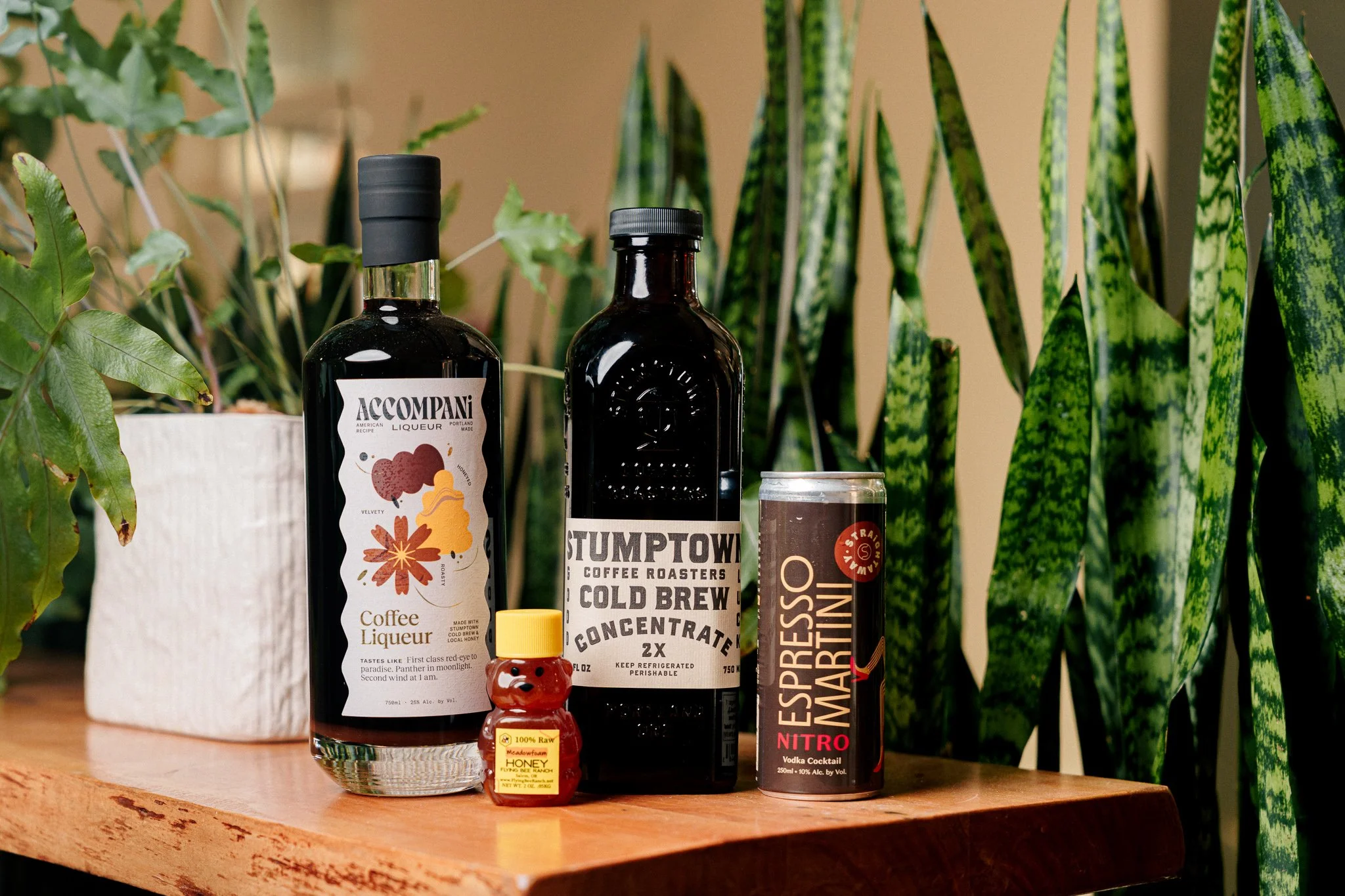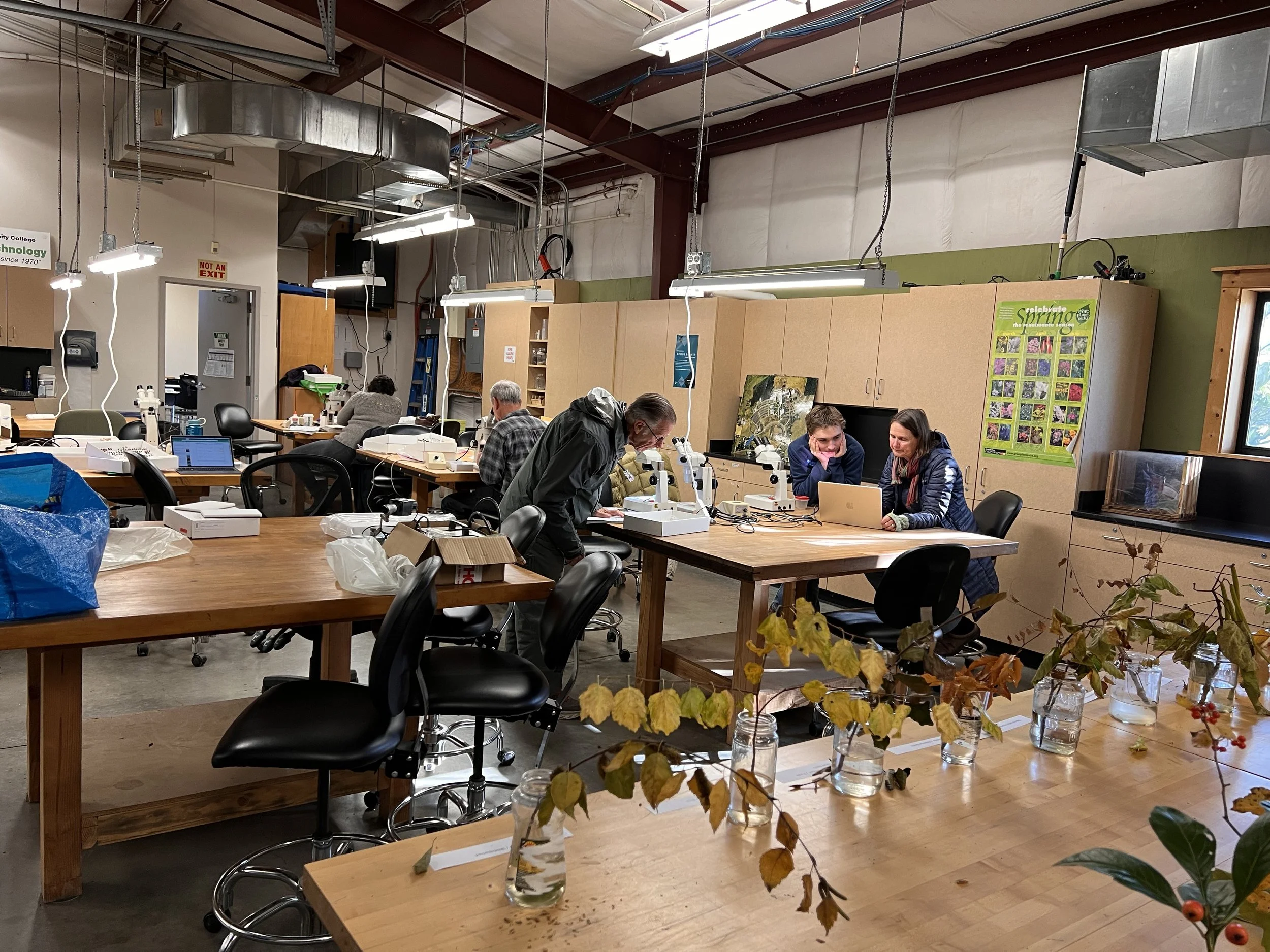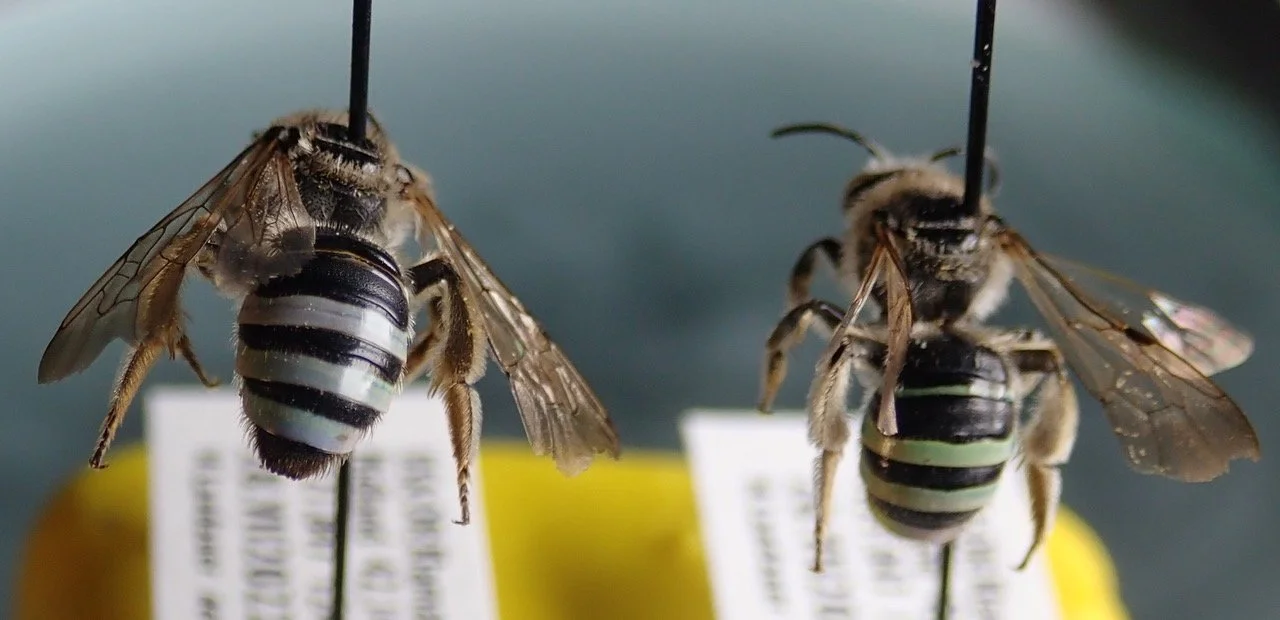if The advisory panel advises the staff, who advises the advisory panel?
YOU DO!
As you read about the doings of the OBA-at-large, do you have thoughts on what we could be doing better, ideas for new activities or approaches or, heck, things that you love that you hope we keep doing or do even more of? The Advisory Panel welcomes your feedback, and you can reach the entire panel at once by emailing your thoughts to atlas_advisory@lists.oregonstate.edu or simply by clicking THIS LINK.
If you have any feedback or submission for Field Notes or if you want to post notes for your regional team contact Ellen Silva (e.silva@comcast.net).
In this issue
Field Notes
Steve Gomes achieved Master level in the Master Beekeeper program! Congratulations to Steve! He is seen here with Professor Ramesh Sigili of the OSU Honey Bee Lab, along with our own Andony Melathopoulos and Jen Larsen.
Three addictions in one
Coffee, alcohol, and… bees?
Bees aren’t technically addictive, though we OBA’ers may disagree. Regardless, we can all agree that it’s great that Straightaway Cocktails is an OBA supporter. They recently launched Accomponi coffee liqueur and Nitro Espresso Martini made with meadowfoam honey; appropriately, a portion of the proceeds from each sale will be donated to the Oregon Bee Project. THANKS, Straightaway! (ed. note: I went down to the tasting room and tried the liqueur. Boy howdy, it was good. I had to buy a bottle as a gift for my husband. Yep, that’s my story.)
OBA announcements
Catch a Buzz
Catch a Buzz is the first TUESDAY of every month at 7pm. To join, go to https://oregonstate.zoom.us/j/97230252365?pwd=TURyTXNMZ1M5SHl2TFQvajBxemtRdz09 | Password: bees
HOLD THE DATE!
It’s official - the annual OBA conference will be held in Corvallis on Sunday, March 5, one day after BEEVent. BEEVent registration starts in February; registration for the OBA conference is starts NOW.
Date/Time: March 5, 2023 from 9am-4:30pm (check-in starts at 8am)
Register by clicking HERE and filling out the form - it’s free to OBA members and students!
See the recent email from Jen Larsen for all the details.
Paranormal? NO - Parataxonomist!!!
Lincoln is recruiting parataxonomists to assist with sorting, curation, and identification of Oregon Bee Atlas specimens. It would be ideal if volunteers were local and could dedicate a few consecutive days in the lab during January and February. Parataxonomists should be confident at identifying bees to the generic level and beyond. Depending on the individual, it may be possible to work remotely. Please contact Lincoln directly by email: Lincoln.best@oregonstate.edu using the subject line “Parataxonomist”.
Road trip!!!
In collaboration with the Understory Initiative located in Ashland, OR, the Oregon Bee Atlas (OBA) will be recruiting surveyors for proposed once monthly sampling at Mariposa Preserve in spring 2023 (April-June). Mariposa Preserve is located on the California border south of Ashland and is within the boundary of the Cascade-Siskiyou National Monument. Volunteers should be proficient samplers that have produced a minimum of 250 specimens for the OBA. Details of the event timing will be forthcoming in late January, but keep in mind that sampling will be weather dependent. To express your interest, please email Lincoln (Lincoln.best@oregonstate.edu) with the subject line “Mariposa Preserve”. No other details are available at this time.
How has the determination label process changed this year?
Here is a quick summary. Please watch Module 6 for all the details (we’re talking to everyone, no matter how experienced).
As in prior years, a location label (generated by the lab staff from your iNaturalist record) is required on every bee turned in.
As in prior years, determination of genus and/or species of your bees is completely optional, though encouraged.
If you determine genus and/or species of any of your bees, use one of the two methods outlined in Canvas Module 6 to digitally log those determinations.
In a change from prior years, adding a determination label to your bees is completely optional.
If you wish to have a determination labels on your bees, you have several choices for obtaining labels.
Prepare your own label document and print your own on acid-free cardstock — See the determinations page and Module 6 on Canvas for resources and instructions.
Request an electronic document with labels prepared with your name already included and print yourself on acid-free cardstock. There are two options for this document.
Option A: “Blank" template — Includes gender symbol, your name, and the year. You must write in genus (and species, if known) yourself.
Option B: Genus template — Includes gender symbol, your name and the year, and includes 2 labels (one female/one male) for each of the Oregon bee genera with genus printed. You must write in any species identifications yourself. A number of blank labels for both sexes are included.
Request a pre-printed sheet of labels, choosing Option A or B above, or both.
Note that the lab will no longer print labels with species names.
If you do add determination labels, please follow the guidance in Module 6, part 3 for bee arrangement in your boxes.
Calendar
Watch the calendar for added or changed events - as the winter proceeds, there could be cancellations, and there WILL be more events!
Team news
If you want to include your own team’s news in the Roundup, send it to Ellen Silva (e.silva@comcast.net) the Monday before we publish (typically, the 1st and 3d Monday of the month).
PDX
The Portland team will continue to hold microscope days at the Portland Community College Rock Creek Campus. Watch the OBA Calendar for dates and cancellations. We do try to get a reminder email out about a week before each event. If you don’t already receive the reminder emails and would like to be on the list, contact Ellen Silva at e.silva@comcast.net.
A recent Portland team scope day - all are welcome, whether you are from the PDX metro area or not. Scopes provided, but extra lighting is very helpful.
cool stuff we have found
In a very exciting discovery, Noelle Landauer has collected wild Nomia melanderi, a matched pair of male and female found in the Klamath area! Per Linc: “Almost no wild populations of Nomia melanderi are known and the USDA are actively searching for them. The concern is that the genetic diversity within managed colonies used for alfalfa pollination is declining and with no known wild populations to draw from, it puts their health at risk.” Kelsey Graham of the USDA will likely visit the site, and we will plan an outing to look for the nesting area and to collect specimens for population genetics analysis by Jonathan Koch USDA.
Nomia melanderi (collected and photographed by Noelle Landauer)
As mentioned last month at Catch a Buzz
At last month’s Catch a Buzz, Linc reported on the exciting find of Micralictoides ruficaudus, the second documented genus from the subfamily Rophitinae (family: Halictidae) for our state. (Bonus points if you can you name the other one*.) Judi Maxwell, Sayaka Lean, and Phylis MacIntosh found several specimens of this California poppy specialist in SW Oregon. Given that Cal poppy only produces pollen, where do these small red-abdomened bees get their nectar? Watch for Linc to mount a scouting expedition next spring, hoping to find the answer. In the meantime, in Judi’s words, here is the story of the initial discovery.
As with all of the exciting bees collected in southwest Oregon, we are clueless about their rarity until we get one of those thrilling emails from Linc. The bees were collected at Rough and Ready Botanical Wayside, 4.5 miles south of Cave Junction on the Redwood Highway. This area is listed as one of 200 of the most important sites worldwide for observing the evolution of unique and rare species in response to harsh and unusual conditions.
Here the engine of the biological diversity is the serpentine soils. Such areas are desert like inspite of receiving as much as 100 to 165 cm of rain a year. The fact that the bees were collected on California poppies adds to their mystique because the flowers provide pollen but no nectar. Are we to assume that their progeny don’t need nectar or does the female collect nectar from another species yet to be recognized?
You will find a lot of information on the Rough and Ready Botanical Area on the web. It is managed jointly by the USFS and the BLM. I hope this whets the appetite of OBA members to visit this area in May. I would love to go field tripping with those intrepid enough to wander this far south.
*Dufourea. But you knew that, didn’t you?!
miscellany (not to be missed)
Catch a Buzz Summary (Martha Richards)
Awards – The awards committee, led by Bonnie Shoffner (who's also on the advisory committee), has created a new standard for awards. Annual awards, given out at our conference in March, will be based on nominations and other mentions. Categories include awards for exemplary service, milestones, outreach achievements, and finding rare bees. There will also soon be a kudos form available so that we can acknowledge and thank our fellow melittologists for helpful or meaningful acts done throughout the year.
Determination Labels – Module 6 has a 5-star rating on Rotten Tomatoes and everyone is talking about it. Don't be left out -- watch it! Unlike those movies that leave you with questions, this one answers everything you need to know about documenting your bee determinations.
License Plate and Excellent Holiday Gift T-Shirt – The pollinator plate is making its way through the wheels of progress. When vouchers are available for pre-sale (possibly in a few weeks), OBA staff will let everyone know. While you're waiting, consider buying a T-shirt to get the word out about the license plate: www.bonfire.com/oregon-bee-plate/ . It's a great conversation starter, excellent fashion statement, and a perfect gift for those people who have everything.
David Jenning's bee foray in the Owyhees, September 2022 – David regaled us with an amazing account of his recent trip to the far southeastern corner of Oregon where he targeted sagebrush areas. He showed videos of wild horses, photos of scorpions glowing under blacklights, gorgeous sunsets, amazing geography, and a tent on the top of his car (because scorpions). He went with a friend in September, so blooming plants were limited to areas near water, but they had a great adventure, found bees from approximately 11 genera, and made us all wish that we had been there with them. This episode of CAB will be posted to Canvas soon, so watch for it and then watch it to see David’s wonderful presentation.
Lessons for next time:
Use iNaturalist to figure out what's in bloom and when. If you're not sure how to do that, make some popcorn and watch Module 5. It's almost as entertaining as Module 6. Almost.
Roads in this area are pretty good when dry but quickly get treacherously slippery when wet. Plan accordingly. Roads also peter out and become impassible. (Ed. note: the roads didn’t look pretty good to me in some places! Do your research before taking off.)
It's a really remote area; David said that it would have been good to have at least two vehicles for safety.
It gets really windy there!
Leslie Gulch and Succor Creek Natural Area are both easily accessible on good roads if it hasn't rained recently. The road to Birch Creek has some rough spots and needs a higher-clearance vehicle. Wadatika Wetlands seemed like it might be a promising place to visit at a different time of year.
Scorpions luminesce under a blacklight flashlight. Keep your tent zipped up. And check your boots in the morning.
If you go on a bee adventure, take lots of photos and videos! You, too can be a featured presenter on Catch a Buzz.
David also said that he's planning another adventure next spring. If you are interested in coordinating with him, drop him an email at pnwnativebees@gmail.com.
eat more pancakes!
Buckwheat pancakes, that is. In the Netherlands, researchers have found that approximately half the pollinators in a field of buckwheat are wild species. We find plenty of interesting bees on wild buckwheats (Eriogonum spp.), so that’s no surprise. In Oregon, buckwheat makes and excellent cover crop - let it bloom and then cut it down to feed the bees and your soil. Read more about the Dutch research HERE.
Diadasian melodies
While reading about Diadasia spp. recently in a woeful attempt to get some specimens to species, I allowed myself to be distracted by a song, the song of the breeding Diadasia rinconis. Who knew bees could sing? Now you do. Check out the original paper HERE and the audio/video recording HERE (the song really gets going about 1:15 into the video - amazing detail of the interaction!)
There is a wide range of shirts and hoodies you can get your fellow bee enthusiasts for Christmas. This includes a new design by our very own Marek Stanon featuring the new bee plate. You can order at the Bonfire website.






